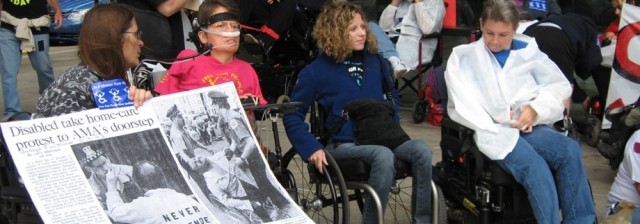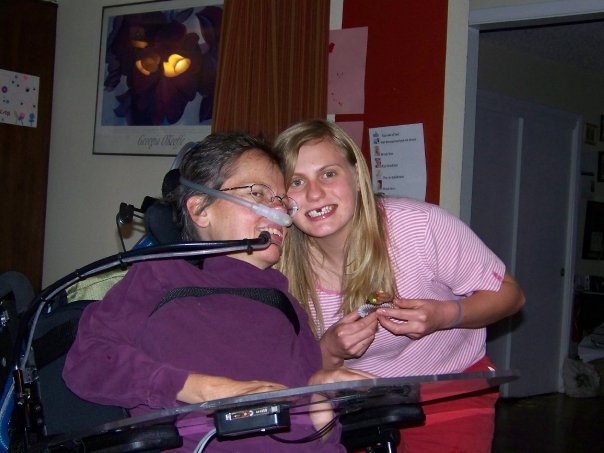Media Driven Disability Stereotypes
This November, Laura Hershey (1962-2010), MFA, disability activist, writer, poet, passed away from a sudden illness aged 48. Based in Colorado she is the author of Survival Strategies for Going Abroad: A Guide for People with Disabilities, a 2005 book offering stories and advice on international travel, published by Mobility International US. Laura Hershey is widely recognized for her organized protests against media driven disability stereotypes including the opinionated Jerry Lewis during his yearly Muscular Dystrophy Association (MDA) fundraising telethons. As a youngster, Hershey herself had been chosen as an MDA telethon “poster child.”
For many years, Laura Hershey argued Lewis’ yearly parading of his “pitiful, helpless cripples” in need of donations was demeaning and his portrayal of their existence as lives not worth living was offensive. When confronted, Lewis responded “…if you don’t want to be pitied for being a cripple in a wheelchair, don’t come out of the house.”
On another occasion, Lewis was asked what he himself would do if diagnosed with Muscular Dystrophy, the performer responded, “…I’d just have to learn to try to be good at being half a person.” Based on the revenue brought in from Lewis’ MDA telethons, the agencies’ administrators are reluctant to correct Lewis’ frequent discriminatory statements. MDA officials fail to acknowledge people making donations totaling millions of dollars form negative and stereotypical opinions of people with disabilities from Jerry Lewis and those who enable him.

Imprinting Stereotypes On Children
Constantly bombarded with dysfunctional comments, questions and mis-representations through mainstream forms of media children as young as three (3) years of age, are able to acquire stereotypical beliefs and adopt negative prejudicial attitudes from their environment. Not understanding the true consequences at the time as these children grow, form friendships and groups, they exhibit negative behavior toward indifference, “outsiders” they have been socialized against.
Children given exposure to cultures outside their own, accepting of gender differentials and families dissimilar to their own dynamic, greatly reduces the inception of stereotypical behavior. Children raised in open tolerant family homes with stability and loving support, where acceptance and punishment is not harsh nor violent, prove more able to achieve in all aspects of life. The question is why would a parent not want this for their child.
Omission Perpetuating Disability Barriers
It is not a parental or media right to incite intolerance of people with a disability. One third of the population has or cares for someone with a disability. These are the people who strive to make life easier for all. If a tetraplegic with spinal cord injury for example can access a bus in their wheelchair you can rest assured a fully able bodied person can easily access.
All to often media reinforce and perpetuate negative bias simply by omission. Western culture emphasizes highly sexualized aesthetic beauty. The predominant image of an ideal lover in popular culture excludes men and women with disabilities. Seldom acknowledged is the beauty and vitality that comes with a disability and even more rare the portrayal as attractive parental and sexual beings.
Persons with disabilities appear to be considered by media as invisible despite the reality that a significant proportion of the universal population has a physical or intellectual disability. Recent surveys from the World Health Organization have determined individuals with some form of disability account for the world’s largest minority: 650 million or 10% of the population. That is exclusive of the, “emotionally crippled” in true Jerry Lewis style.
Conclusions
Media will continue to present skewed, stigmatized representations of people with disabilities, perpetrating stereotypes. Misinformed is no excuse for ignorance. That is not to say all media coverage discriminates against disability. Prejudice against disabilities and sociological notions relegating the disabled body as something to be hidden are slowly changing.

With her untimely death, Laura Hershey leaves her partner to raise their young daughter alone. Hopefully by the time Ms. Hershey’s daughter is an adult there will be greater acceptance and healthier attitudes toward people with disabilities garnering media attention.
“I wrote “Monster Body” in celebration of my own disability. I aimed to acknowledge my body’s struggles, including compromised respiratory function, and its primary interface with the world, the base of my spirituality.” – Laura Hershey
Monster Body – by Laura Hershey
I mock the human form
My back, shell-sharp curve, my thin wrist bone
Limbs that do not twitch beyond the digits
Illustrate terror, the randomness of damage
Right lung so different from left
Thrust forward, fuller-breathed
Its more delicate mate shrunken
Adjusting to a smaller, collapsing cage
Brief breaths, bent bones
Muscles weak as water, still as sleeping stars
Monster mine, monster body
One I would not trade
Not Shelley’s “hideous phantasm”
Just parts made from imperfect materials: sinew, scar
Cells, fluid, fat, and heart
Still I roar when burned by exile
Mobs swinging angry torches through stone streets.
Stubborn flesh threat of frail menace
Vulnerability shocking as violence
Dangerous, I carry
Secrets in my castle, fainted women in my healing search
Empathy repatriates me.
I take this shape, my body
Monster body mine
By my body I journey,
I learn, I love.
It is my lens, my light.
Kind Regards
Deb
Resources
- The Denver Post (November 28, 2010)
- New Mobility Magazine (June, 2001)
- World Health Organization (2010)
- Chest Foundation: http://www.chestfoundation.org
- Laura Hershey Official Website: http://www.laurahershey.com
Recent Comments